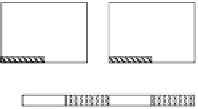Information Technology Reference
In-Depth Information
Encoder
#1
Decoder
#1
Video 1
Video 1
1
2
Encoder
#2
Decoder
#2
Video 2
Video 2
3
4
Encoder
#3
Decoder
#3
Video 3
Video 3
1
bit 3
0
bit 2
1
bit 1
0
bit 0
Encoder
#4
Decoder
#4
Video 4
Video 4
Fig. 9
Synchronization achieved by sync marker in non-multiplexing mode
The second synchronization method is the sync marker scheme, which is mainly
useful with multiple conventional HDTV encoders and decoders in the non-
multiplexing mode. Many conventional decoders do not have an STC sharing
scheme and cannot deal with ancillary data, such as that in time code information.
Our encoder places a sync marker on the top or bottom of the active line of each
channel of the image, as shown in Fig. 9. The decoded images on the receiving side
are synchronized with a multiple frame synchronizer that we have developed [1].
The benefit of this sync marker scheme is that the latest CODEC can be used for
SHR video compression. We can replace the MPEG-2 CODEC with the latest H.264
CODEC without changing the construction of the SHR system.
6
Rate Control in Multiplexing Mode
We introduced a two-stage encoding system to equalize and improve the encoding
quality of all partial frames. The system consists of pre-encoders, main-encoders,
and a controller, as outlined in Fig. 10. The pre-encoder encodes and analyzes the
input partial frame, and sends encoding parameters such as image complexity and
the number of encoded bits to the controller. All pre- and main-encoders operate in
parallel by receiving a common signal from the controller. Because of the time delay
generated by the frame buffer in front of the main-encoder, the four main-encoders
encode the (
N
+1)-th frame when the four pre-encoders encode the first frame (
N
is
GOP size).
The details of this rate control flow are given in Fig. 11 and it consists of five
stages. First, the
i
-th frame is input to the pre-encoders, and the (
i
N
)-th frame is
also input to the main-encoders in Stage 1. The reason the main-encoders input a
delayed frame is to improve their own encoding quality. It is well known that scene
changes degrade the encoding quality. If the encoders can detect future alterations
of the image complexity such as scene changes, they can better distribute target
bits to all frames, and minimize the degradation in encoding quality. Large delay
−





































